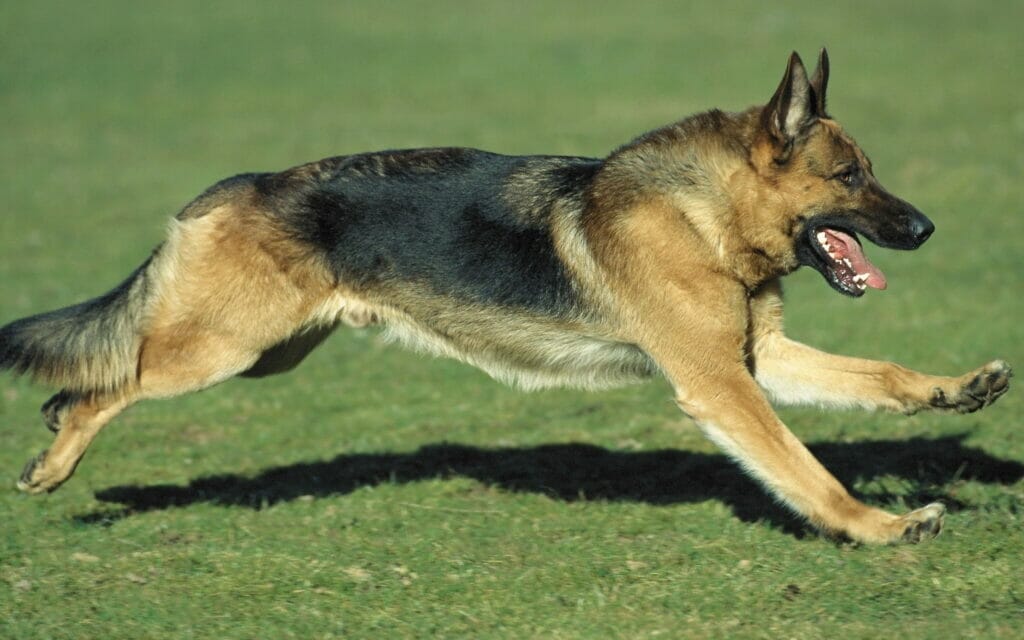How to Make Your German Shepherd’s Back Legs Stronger
Our focus for today’s discussion is a topic that’s vital for the health and longevity of our furry companions: “How to make your German Shepherd’s back legs stronger.”
German Shepherds are highly active dogs, renowned for their agility, speed, and strength. However, they are also prone to hip and elbow dysplasia, a condition that can lead to weakness or lameness in their hind legs. As such, ensuring the strength of your German Shepherd’s back legs is an important part of maintaining their overall health.

However, remember that strengthening exercises should be undertaken carefully, particularly if your dog already exhibits weakness or is recovering from an injury. Always consult your vet before starting a new exercise regimen, and stop immediately if your dog shows any signs of pain or discomfort.
1. Regular Exercise:
Regular, controlled exercise is crucial for maintaining your German Shepherd’s hind leg strength. Controlled exercise means activities where your dog isn’t likely to overdo it and injure themselves, such as leashed walks or gentle play sessions.
Consistent exercise not only helps maintain muscle mass, but it also keeps your dog’s joints flexible and helps manage their weight. Obesity can put excessive strain on your dog’s joints, leading to weakness or injury.
2. Targeted Training:
Certain exercises can specifically target your dog’s hind legs to build strength:
- Sit to Stand: Just like human squats, this exercise works the major muscle groups in your dog’s hind legs. Ask your dog to sit, then to stand. Make sure your dog is standing and sitting correctly each time, not just popping up and down.
- Hind Leg Balancing: This exercise involves asking your dog to balance on their hind legs only. With your dog standing in front of you, hold a treat over their head and slowly move it backward, encouraging them to lift their front paws off the ground. However, ensure the exercise is performed safely without stressing the dog.
- Walking Backwards: Teaching your dog to walk backward can help improve their hind leg strength. It encourages them to use their back legs more actively.
3. Physical Therapy:
Canine physical therapy, also known as canine rehabilitation, is a fantastic resource for dogs with hind leg weakness. Canine physical therapists are trained professionals who use a variety of methods, including stretches, targeted exercises, and sometimes equipment like balance balls or treadmills, to improve a dog’s strength and mobility.
4. Hydrotherapy:
Hydrotherapy, or water therapy, is another great option for strengthening a dog’s hind legs. Swimming is a non-weight-bearing exercise, meaning it allows your dog to build muscle strength without putting pressure on their joints. Some canine rehabilitation centers also have underwater treadmills, which combine the resistance of water with the benefits of walking or trotting.
5. Proper Nutrition:
A balanced diet is crucial to your German Shepherd’s overall health, including their muscle strength. Ensure your dog’s diet is rich in high-quality proteins to support muscle growth and repair.
Supplements can also be beneficial, especially as your German Shepherd ages or if they have a condition like hip dysplasia. Glucosamine and chondroitin are commonly used to support joint health, but always consult your vet before starting any new supplement regimen.
6. Regular Check-ups:
Regular vet check-ups are essential for monitoring your German Shepherd’s overall health, including their muscle and joint health. Early detection of issues can lead to more effective treatment and can prevent minor problems from turning into major ones.
7. Massage and Stretching:
Massaging your dog’s hind legs can help increase circulation and relieve tension in the muscles. Use long, gentle strokes moving from the hip down to the foot. Remember, this should be a soothing experience for your dog, so if they seem uncomfortable, stop.
Stretching is also beneficial. A common stretching exercise is the “bicycle” movement, where you gently move your dog’s leg in a motion that mimics pedaling a bicycle. However, it’s essential to learn the correct techniques to avoid causing injury. A canine physical therapist can provide guidance.
8. Appropriate Rest:
While regular exercise is crucial for strengthening your German Shepherd’s back legs, so is appropriate rest. Over-exercising can lead to fatigue and injury. Allow your dog ample time to rest and recover after physical activities.
9. Mental Stimulation:
While it might seem unrelated, mental stimulation can help keep your dog active and mobile. Dogs that are mentally stimulated are more likely to engage in physical activity, which in turn benefits their overall muscle health. Mental stimulation can come from training, puzzle toys, interactive games, or even just spending quality time with you!
10. Comfortable Environment:
Your German Shepherd’s living environment plays a role in their back leg strength. Provide them with a comfortable, supportive bed to rest their muscles and joints. Avoid slippery floors, as these can lead to falls or abnormal walking patterns as your dog tries to maintain their footing.
In conclusion, maintaining and improving your German Shepherd’s back leg strength is a multi-faceted process involving exercise, nutrition, regular vet checks, and more. By being proactive and keeping your dog’s back legs strong, you’re helping to ensure a higher quality of life and longevity for your furry friend.
Always remember, your vet is an invaluable resource. If you have concerns about your German Shepherd’s back leg strength or overall health, don’t hesitate to reach out to them. With their guidance and your commitment, your German Shepherd will be on the right track to having strong, healthy back legs!







